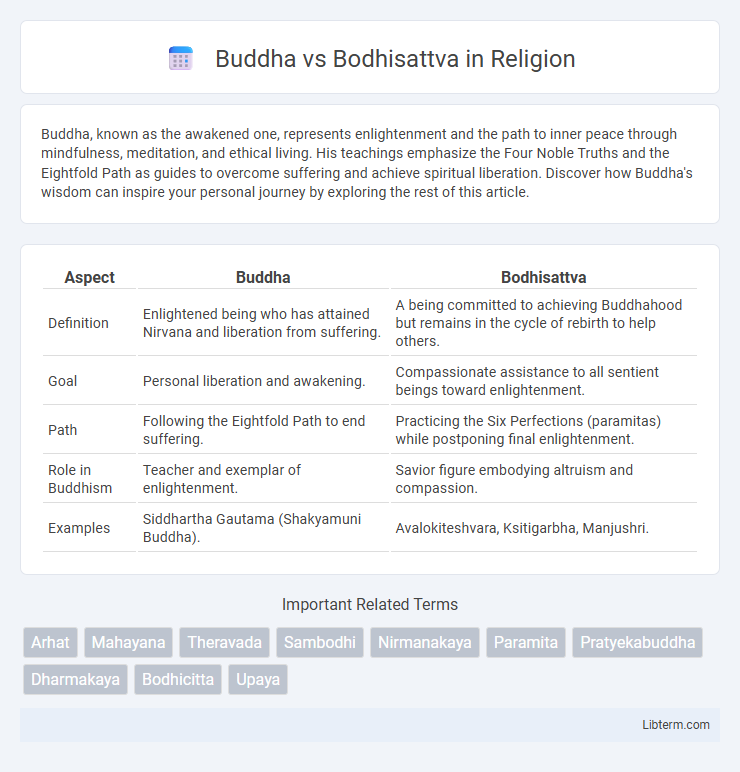Buddha, known as the awakened one, represents enlightenment and the path to inner peace through mindfulness, meditation, and ethical living. His teachings emphasize the Four Noble Truths and the Eightfold Path as guides to overcome suffering and achieve spiritual liberation. Discover how Buddha's wisdom can inspire your personal journey by exploring the rest of this article.
Table of Comparison
| Aspect | Buddha | Bodhisattva |
|---|---|---|
| Definition | Enlightened being who has attained Nirvana and liberation from suffering. | A being committed to achieving Buddhahood but remains in the cycle of rebirth to help others. |
| Goal | Personal liberation and awakening. | Compassionate assistance to all sentient beings toward enlightenment. |
| Path | Following the Eightfold Path to end suffering. | Practicing the Six Perfections (paramitas) while postponing final enlightenment. |
| Role in Buddhism | Teacher and exemplar of enlightenment. | Savior figure embodying altruism and compassion. |
| Examples | Siddhartha Gautama (Shakyamuni Buddha). | Avalokiteshvara, Ksitigarbha, Manjushri. |
Introduction to Buddha and Bodhisattva
Buddha, meaning "The Enlightened One," refers to Siddhartha Gautama, who attained full enlightenment and liberation from the cycle of birth and death (samsara) through profound meditation and insight. A Bodhisattva in Mahayana Buddhism is a being dedicated to achieving enlightenment not solely for personal liberation but to help all sentient beings attain Buddhahood, embodying compassion and selflessness. While the Buddha represents the ultimate state of awakening, Bodhisattvas are revered for their vow to postpone final nirvana to assist others on the path to enlightenment.
Defining the Buddha: Enlightenment Personified
The Buddha is an enlightened being who has attained complete awakening and liberation from the cycle of birth and death, embodying perfect wisdom and compassion. Unlike Bodhisattvas, who delay their own final enlightenment to help others achieve awakening, the Buddha has realized Nirvana and serves as the ultimate example of spiritual fulfillment. The historical Buddha, Siddhartha Gautama, represents this realization and the path to enlightenment in Buddhist teachings.
Understanding the Bodhisattva Path
The Bodhisattva path emphasizes compassion and altruism, where an individual vows to attain enlightenment not just for themselves but to aid all sentient beings in overcoming suffering. Unlike a Buddha, who has achieved complete enlightenment and nirvana, a Bodhisattva postpones final liberation to assist others on their spiritual journey. This path involves cultivating virtues such as patience, generosity, and wisdom, fostering an ongoing commitment to universal compassion and selfless service.
Core Differences: Buddha vs Bodhisattva
A Buddha is an enlightened being who has achieved complete liberation from the cycle of birth and death (samsara) through self-realization and awakening, embodying perfect wisdom and compassion. A Bodhisattva, in contrast, is an individual who has generated the aspiration to attain Buddhahood but deliberately delays final enlightenment to help all sentient beings achieve liberation. The core difference lies in their spiritual goals: the Buddha has attained full enlightenment and nirvana, whereas the Bodhisattva remains engaged in compassionate activity within samsara to guide others toward awakening.
Philosophical Foundations and Teachings
Buddha represents the Enlightened One who has attained Nirvana through self-realization and cessation of suffering, emphasizing personal awakening and liberation from the cycle of rebirth. Bodhisattva embodies the Mahayana ideal of compassionate beings who delay their own Nirvana to assist others in achieving enlightenment, highlighting altruism and collective salvation. The philosophical foundation contrasts the Theravada focus on individual liberation with the Mahayana commitment to universal compassion and bodhicitta, the awakened mind geared towards freeing all sentient beings.
Roles in Mahayana and Theravada Traditions
In Mahayana Buddhism, Buddhas are fully enlightened beings who have attained Nirvana and transcend worldly existence, while Bodhisattvas delay their own final enlightenment to assist all sentient beings in achieving liberation, embodying compassion and selflessness. Theravada tradition primarily emphasizes the Buddha as the singular enlightened teacher and ideal, focusing on individual liberation (Arhatship) rather than the Bodhisattva ideal. The Bodhisattva role is central in Mahayana practice, representing an altruistic path beyond personal enlightenment, whereas in Theravada, Bodhisattvas are seen as rare and primarily associated with the historical Buddha's previous lives.
Compassion and Wisdom: Comparing Qualities
Buddhas embody the perfect union of compassion and wisdom, having transcended suffering through enlightenment and guiding others by example. Bodhisattvas are beings committed to attaining Buddhahood while actively cultivating boundless compassion to relieve the suffering of all sentient beings, emphasizing altruistic action over personal liberation. The contrast highlights Buddhas as fully awakened teachers and Bodhisattvas as compassionate aspirants whose wisdom deepens through continued practice and selfless devotion.
The Journey to Enlightenment: Stages and Goals
The Buddha's journey to enlightenment involves achieving Nirvana through the Four Noble Truths and the Eightfold Path, culminating in the cessation of suffering and liberation from the cycle of rebirth. Bodhisattvas embark on a prolonged path marked by the Six Perfections--generosity, morality, patience, energy, meditation, and wisdom--aiming not only for their own enlightenment but also for the liberation of all sentient beings. While a Buddha attains full awakening and exits the cycle of samsara, a Bodhisattva intentionally postpones final Nirvana to guide others on their spiritual journey.
Popular Buddhas and Famous Bodhisattvas
Popular Buddhas such as Gautama Buddha, the historical founder of Buddhism, and Amitabha Buddha, revered in Pure Land traditions, represent enlightenment and the attainment of Nirvana. Famous Bodhisattvas like Avalokiteshvara, symbolizing compassion, and Manjushri, embodying wisdom, dedicate themselves to helping all sentient beings achieve enlightenment without entering Nirvana themselves. These figures are central in Mahayana Buddhism, shaping devotional practices and iconography across East Asia.
Contemporary Relevance in Modern Buddhism
Buddhas represent the attainment of full enlightenment and liberation from the cycle of birth and death, embodying ultimate wisdom and compassion in modern Buddhism. Bodhisattvas symbolize ongoing commitment to aiding all sentient beings in achieving enlightenment, emphasizing altruism and social responsibility in contemporary spiritual practice. Their interconnected roles reflect the balance between individual awakening and collective compassion essential to modern Buddhist communities and ethical engagement.
Buddha Infographic

 libterm.com
libterm.com